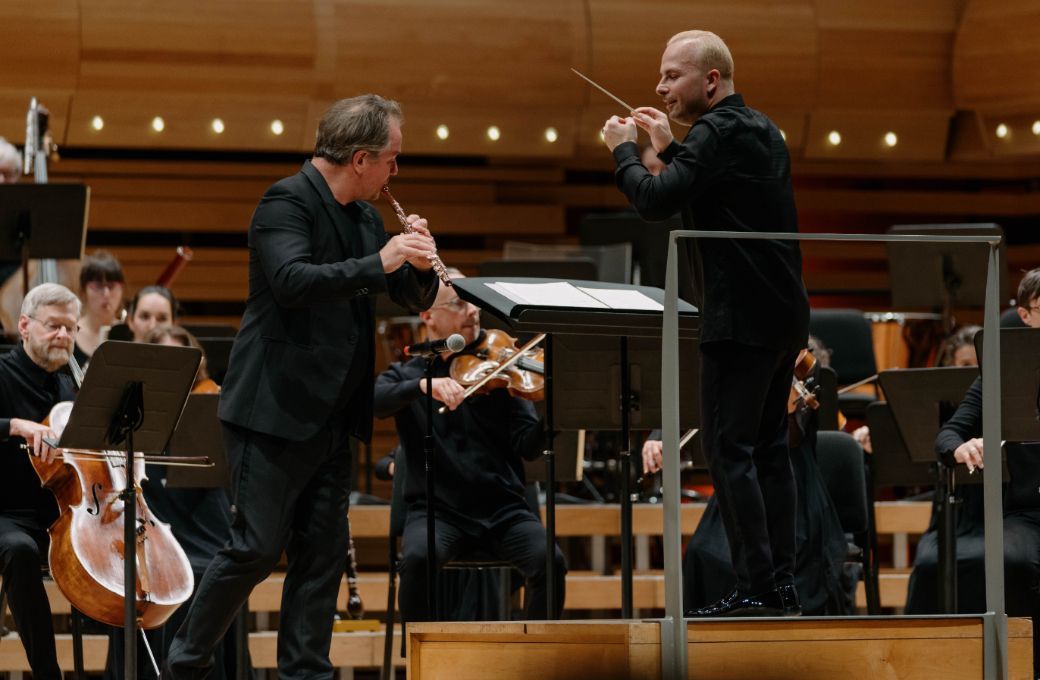Any performance featuring two renowned international artists raises expectations; flutist Emmanuel Pahud and conductor Yannick Nézet-Séguin did not disappoint. Flute showpieces were bookended by two orchestral works on this program wholly comprised of music by French composers. The Orchestre Métropolitain began with Debussy’s Petite Suite, which commences with a lengthy flute solo. To play that solo to an audience sprinkled with flute afficionados, not to mention Emmanuel Pahud listening in the wings, would be daunting to say the least. Furthermore the extremely slow tempo (despite the Andantino marking) taken by Nézet-Séguin meant that it was a testament to the commitment of the players that an ethereal effect was ultimately conjured. In the course of this short work, the mood later transitioned from playful to boisterous; however the overall emotional impact was transitory; the music didn’t jump off the page.
We moved from Debussy’s impressionism to the French romanticism of Cécile Chaminade, whose Concertino in D major is not well-known outside the flute sphere. The OM came alive here, a tribute to the power of Pahud’s artistry. His high D at the end was astounding, the single most impressive sound of the entire concert. In Lennox Berkeley’s orchestration of Poulenc’s Flute Sonata, Pahud squeezed every last drop of musicality from each phrase. The rubato and alterations to some of the embellishments in the original solo flute part employed by Pahud suited the shift from piano to orchestral accompaniment. Kudos to the OM’s bassoonists whose tasteful contributions enhanced the Subito lento section of the final movement. In both the Chaminade and the Poulenc, Nézet-Séguin’s skills as a collaborator came to the fore; he consistently demonstrates an uncanny capacity to feel the music in concert with his soloists.

There could be little argument that Pahud is currently the planet’s number one flutist. He continues the line of French masters that began with Claude-Paul Taffanel and Marcel Moyse and progressed through Jean-Pierre Rampal and Aurèle Nicolet (Pahud’s teacher). Pahud manifests stunning control in all registers and at all dynamic levels; he can weave long seamless phrases by taking a catch breath while the sound of the previous note is still resonating. His musical imagination is sagacious. On this occasion his creativity vaulted two works on the fringes of the orchestral repertoire that pose minimal technical challenges from a potentially pedestrian treatment to an experience that was mesmeric for each and every listener in the hall.
No doubt some were disappointed by Pahud’s choice to simply reprise the end of the Poulenc for his encore; however it could be interpreted as a humble gesture on his part to not step out of his role as the OM’s collaborator by potentially upstaging them with a protracted tour de force.
Finally, a Parisian composer whose oeuvre bridged the gap between the classical and romantic periods. Louise Farrenc’s Symphony no. 1 in C minor began with some exquisite clarinet solo work by Simon Aldrich. Subsequently the lyricism catalyzed by Nézet-Séguin in the Adagio cantabile was nothing short of spell-binding. This sublime symphony deserves to be played more widely.


